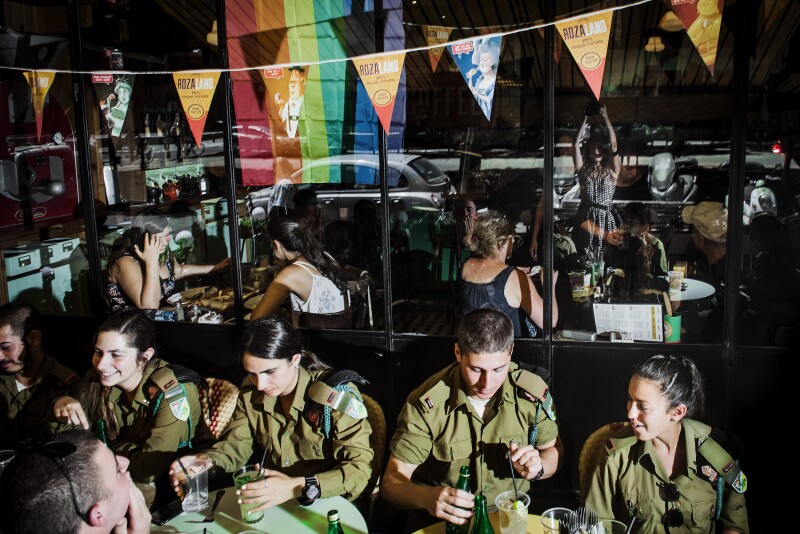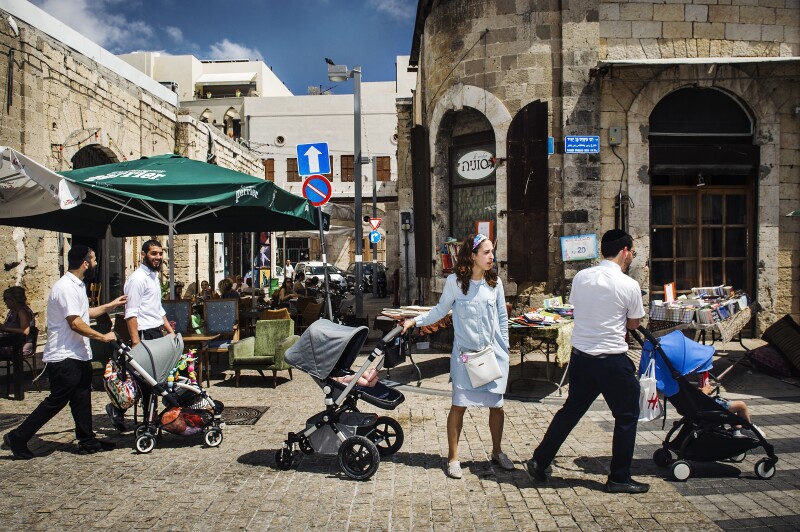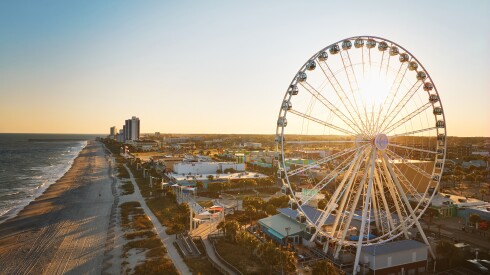When it comes to cities, photographer Dina Litovsky likes them noisy and chaotic and overwhelming. “My photography focuses on people and street scenes,” she says. “Cities like Tokyo and Hanoi that are so busy and kaleidoscopic, that’s what I like. So when I found out I was going to Tel Aviv, I thought, this is a city where I can be myself.”
Her camera bag was packed. She added sunscreen. She didn’t plan much, but in the 24 hours before she left, she booked a guide and did a Google image search. “I wanted to have a picture of the city as it is right now,” she says. “In the photos, Tel Aviv looked really clean, with white Bauhaus buildings and people sitting in cafés. It looked like the French Riviera.”
Her five days in the city gave Litovsky a different impression. “I came to think of the city as this big flea market,” she says. “It’s claustrophobic and loud and fast and very, very colorful. It’s a mix of cultures and street smells and food.”
“I used photography to make sense of the chaos.”
She spent most of her time tracking down Tel Aviv’s busiest pockets. “The city really transforms based on the time of day,” Litovsky says. “I would just ask my guide, ‘It’s noon, where are there going to be the most people?’”
This quest led her to the beaches that stretch north along Tel Aviv’s coastline. It took her to the Florentin neighborhood, where “there are cafés upon cafés with people eating and drinking” late into the night. She tagged along with soldiers on their lunch break and convinced a group of gruff men to let her photograph their sidewalk backgammon game.
As she walked and observed, cajoled and shot, she noticed something else.
“It’s a small city, but there are so many different people there—and they travel in groups. You have older men playing cards. You have younger hipsters in cafés. You’ll see orthodox Jews and religious Muslims, and right next to them a group of gay boys in briefs. It’s a little schizophrenic.”
One day, her guide explained that a tel in Hebrew is an archaeological site—a hill made up of layers of civilizations built on top of one another. “And I thought, ‘Oh, that makes sense.’ That’s what I wanted to capture: layers of people with the city as the background. I used photography to make sense of the chaos.”

Photo by Dina Litovsky
“Many of the soldiers I saw were very young, like 18 and 19, and at lunch they go to cafés to eat in uniform, with guns. I took an exploratory shot of these soldiers and liked it, so I asked if I could follow them. I spent about an hour at a table nearby, just watching them like a hawk. I didn’t talk to them much—there was a language barrier, so we just smiled at each other—but it’s also because I try not to talk to my subjects. It changes the dynamic of the photo. I’m looking to capture a natural state. I’m trying to capture the interaction between other people, not the interaction with me.”

Photo by Dina Litovsky
“In Tel Aviv, there’s a stretch of beach that goes all the way from the south to the north. The beaches change in such a crazy way. In the south, the Jaffa part, you see a lot of religious Muslim families and women who are bathing, totally covered. (They did not want to be photographed.) The farther north you go, the more the people change—and, I found, the more people enjoyed getting photographed. There’s a religious beach for the ultra-Orthodox, which I couldn’t go to, a tourist beach, and a locals’ beach. I ended up just south of Hilton Beach, where there’s a gay beach. There were few tourists and no Muslim families and no religious Jews, just a lot of scantily dressed people having a big party.”

Photo by Dina Litovsky
“The arts and crafts market at Nachlat Binyamin Square takes place on Tuesdays and Fridays of every week and is a busy, popular place with both tourists and locals. I wanted to shoot some people passing through and the father in cool-looking shades with a colorfully dressed baby caught my attention.”

Photo by Dina Litovsky
“One of the biggest things that surprised me was that Tel Aviv was the most LGBT-friendly city I have ever been in. I was there right after the love parade and there were rainbow flags everywhere. There was such a great attitude [toward gay people], that I didn’t expect.”

Photo by Dina Litovsky
“This was taken at Hummus HaCarmel, a famous hummus stand in Carmel Market in the center of Tel Aviv. The entrance is designed to remind people of a synogogue, with colored stained glass and Judaic texts lining the walls.”

Photo by Dina Litovsky
“I’ve never seen so many kids in one country—there were so many people with kids out at all times of day and night.”

Photo by Dina Litovsky
“In general, I get nervous approaching people, so I would take a shot of arak, which is an Israeli liquor, before I approached people I wanted to shoot. Once I get in the flow it becomes easier again,” she says. “I didn’t really talk to these men—I asked if I could take some photos. I was there for maybe 15 minutes. They were just sitting around, making jokes. They’re sitting in the shade, so I had to use the flash—without the flash, they would be totally in the dark. Everything else about the moment is a little fuzzy because when I’m shooting, I’m all in the shot—I don’t really pay attention to the details around it.”

Photo by Dina Litovsky
“Across from Bograshov Beach, this boy with a water gun was standing on the sidewalk and caught my eye.”

Photo by Dina Litovsky
“My guide told me these are the hippies of Tel Aviv. Every Friday, they meet behind the Dolphinarium, a nightclub that was bombed 16 years ago, for a sunset drum circle. It’s a nonreligious Shabbat ceremony. They dance and sing and play drums in front of this graffitied wall. The drum circle is a very local thing—I never would have found it without my guide. I was there for about an hour, but I didn’t want them to feel like I was just there to steal pictures, so I put down my camera and danced with them.”

Photo by Dina Litovsky
“One afternoon we caught a performance by Miri Aloni, a famous Israeli folk singer, who regularly sings on the street by Carmel Market.”

Photo by Dina Litovsky
“One day, as I was walking through the new part of Jaffa, I saw these three couples. There are two women outside the shot, but I thought it was interesting that men were with the strollers. I followed them for about three blocks, looking for the layers. When I got this shot, with the café couches and chairs in the background, the babies’ legs, and the man looking at me and smiling, I knew I had it.”











